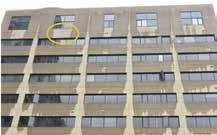
4 minute read
April showers bring May (and spring) building leaks
Springtime brings with it many idyllic visuals – buds on trees, flowers blooming, and staining at balcony corners. Wait... what?!
By Heather Elliot, P.Eng., LEED® Green Associate, Associate, Entuitive
Yes, stains are a treasure map when it comes to building inspection, leading us to potential sources of moisture management and drainage issues! One of the best times of year to perform a visual inspection of the exterior systems at condominium properties is when the spring rains begin. This is time to check for signs of potential weak points in the building envelope and assess overall moisture management. This article will share the causes of leaks, the effects of leaks and what you can do about them.
Causes of leaks
Leaks are most often caused by: • roofing, cladding, and sealant failures; • voids in water resistive barriers, dampproofing, and waterproofing; • defective flashings and drainage methods.
The first two items may relate to aging of assemblies, but can also become a factor if poor quality materials or detailing were used in the original construction. The third item is something that can often become apparent immediately following a large rain.
A review of your building exterior can showcase staining and areas of repeated wetting, especially if done at this time of year. The effects can often be obvious. Take the image below – can you tell which band of windows has flashing at the base? Flashing is generally prefinished metal extended beyond the face of cladding and bent out with a drip edge to help force water to drip off before wetting cladding below.
In this case, one row of windows at the top floor has sill flashing with a drip edge (one typical window highlighted), and you can see how it is more effectively directing water away from the wall compared to lower level windows where cladding is wet below. Other areas that exist on a variety of condominium buildings and where staining is often first noticed include: • balcony and window corners, where water can be directed against the adjacent wall instead of out and over the leading edge of the balcony or windowsill;
• areas where roof gables intersect with other assemblies such as chimneys and walls, but no flashing is provided to direct water away; and • below ends of eavestroughs where they are installed tight against adjacent walls or where the gutter repeatedly overflows.

Effects of leaks
Repeated wetting that does not get the chance to dry out between rains can cause accelerated deterioration of finishes and eventually, damages to underlying elements. The effects of poor moisture management may extend all the way through the building. Although elements closest to the exterior are likely to be the most affected, water also tends to follow the pathways open to it, sometimes finding its way deep into the structure. A question to ask if significant signs of moisture staining are noted is “are the interior materials resilient enough to withstand intruding moisture, or will they be damaged?”
In wood frame construction, if temperatures are right, deterioration can begin as soon as materials become wetted. The longer water ingress goes unaddressed, the larger the overall cost and disruption will become when repairs are completed.
Intruding moisture can also create problems with indoor air quality. Moisture can combine with organic material in wood and facers used in building products, such as framing and drywall, to create a breeding ground for rot and mould.
What you can do about them
Moisture-related damage can be minimized if the more obvious signs are addressed proactively. By focusing on potential weak points and addressing aging systems through repairs and replacements, it is likely that the interior elements will never be exposed to water.
Following a large rainfall or other precipitation event, it might also be useful to check:
• eavestroughs for adequate slope and ability to drain. If eavestroughs are undersized, walls below may be wetted due to overflow;
• downspouts to ensure water is directed away from building foundations and does not pool. Use splashpads and downspout leader extensions to control the flow; and • plaza areas, decks, and balconies for ponding water. Generally, water should be able to drain freely to internal drains or from the leading edge, with no standing water after a 24-hour period.
And when things have dried up from that rainfall, check alignment of landscaping sprinklers to ensure they are not repeatedly wetting the base of a wall.
Spring is in the air, the birds are singing and we should all be out enjoying the green grass, as well as the finer views this season brings. If those views are marred by things like staining, it is time to take a second look! n










